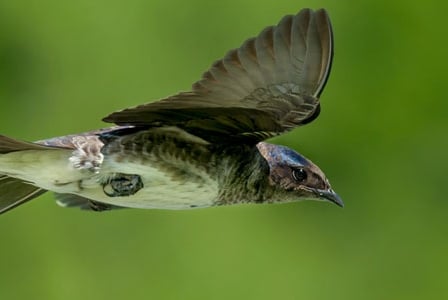
If youre not a fan of mosquitoes, then you should be a fan of purple martins! Learn why on this Wildlife Wednesday.
It’s not uncommon to hear a co-worker, a friend, or a family member complaining about their long commute. But is their commute as long as the ones undertaken by these frequent flyers? (Probably not, seeing as they’ll travel more than 640 km to get back home after a busy day of foraging.)
Habitat
Being migratory, purple martins wing their way between North and South America, so depending on the season, they can be found as far north as Canada or as far south as Peru and Brazil. Once they reach their summer (or winter) homes, they nest near wetlands, swamps, or other damp and open areas.
Trivia
- Purple martins are the heavyweights of the swallow world, weighing in at a scale-crushing 56 g and measuring an impressive 20 cm from beak to tail.
- If you’re not a fan of bothersome bugs, then you may want to invest in a bird house. These beaked bug-munchers are insectivores—they eat only insects—and can gulp down up to 2,000 mosquitoes or 400 flies in one day!
- Reminiscent of their cousin the peacock, it’s the male martins that get to show off their pretty hue. While males sport shiny, purple-black plumage, females’ feathers are blue-tinged grey, and feature a smudge of white along the breast.
- Females, though, are less interested in the male’s pretty plumage and more interested in the spots he chooses for future nests. If she likes the potential nesting sites, they work together to build a home of green leaves, mud, sticks, feathers, and other materials.
Why are they threatened?
In Canada, martin populations have seen some decline; in BC, this decline has led agencies to consider the flighty fellows to be considered “at risk.” However, researchers still aren’t entirely sure why populations are plummeting.
One theory suggests that a classic case of the early bird getting the worm—or the nesting site—is at play, as purple martins have to compete with two introduced bird species, the European starling and the house sparrow, for nest cavities.
Other theories suggest that decreases in food availability, threats in their nesting grounds and migratory routes, or other effects cause by climate change may be at fault.
However, conservations efforts across Canada and the US have taken flight. Nature Canada, for one, has partnered with researchers, environmental groups, and the Canadian Wildlife Service to found the Purple Martin Project. The project tracks the birds as they migrate each year in an attempt to better understand the risks they face.



